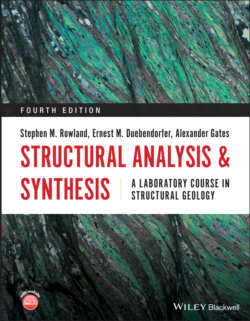Читать книгу Structural Analysis and Synthesis - Stephen M. Rowland - Страница 15
Problem 1.3
ОглавлениеFault surfaces can contain slip lineations (fault striae). Such slip lineations can be used to determine the orientation of a slip on a fault and, therefore, whether the motion on the fault was strike‐slip, dip‐slip, or oblique‐slip. A geology student who was just learning to use a pocket transit recorded the orientations of five slip lineations on one fault surface. The strike and dip of the fault surface is 320°, 47°NE. The student’s five recorded lineation orientations are recorded in the table below.
Determine which lineation orientations are feasible and which ones must represent a mistake on the part of the student because the given orientation does not lie within the fault plane. Give a brief explanation for each of your five answers. For the valid lineation orientations, indicate which type of fault motion is indicated.
| Lineation (plunge and trend) | Feasible? (yes or no) | Explanation | Type of motion indicated (strike‐slip, dip‐slip, or oblique‐slip) |
| 34°, due north | |||
| 0°, 140° | |||
| 33°, N66°W | |||
| 47°, 050° | |||
| 75°, due north |
